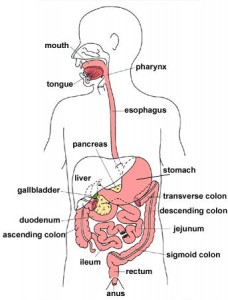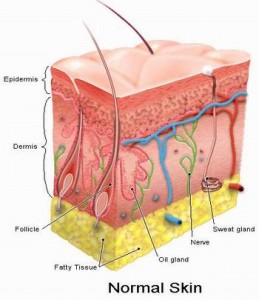Last Updated on July 26, 2020
In this article you’ll discover why most of what we put on our skin should not be there. You’ll also discover a super easy way to tell if a substance belongs on your skin or not. It’s a no-brainer. What’s more, you can save a lot of money by doing away with the toxic products you might still be buying, and also discover how to make your own natural versions of the products you may be dependent on (like hair cleanser).
Did you know that your digestive track is technically on the exterior of your body?
It’s easy to think that the stomach, for instance, is inside the body in the same way the heart of the brain is inside the body, but it’s not. The digestive track is a tube that the body is wrapped around, in a sense. The picture on the right is a cross section of the intestine, clearly showing the structure of this tube. The cells on the outer side of this tube are inside the body, whilst the space in the middle of this tube is technically outside the body.
The cells at the surface of the digestive tract are not dramatically different from the cells at the surface of the skin. Both are designed to allow (and block) the flow of certain substances from outside the body to inside the body.
It’s obvious to most people that what we eat, via our mouth, will end up within the body. Eat a deadly poison and you may die or get very ill.
The same, however, applies to the skin. When you rub stuff (a highly technical term) onto your skin much of it is ingested by the body. The net result being that you eat this stuff, via the skin.
What occurred to me many years ago is that if I would not be happy to eat something (if it would taste toxic, make me vomit, or make me ill or nauseous, or have some other unhealthy consequence) via the mouth, then I should also not be happy to put it on my skin. The basic principle of came up with from this realisation was this: If I wouldn’t or couldn’t eat it, then don’t rub it onto the body.
Do you notice the similarity between the tissue structure on the Normal Skin picture, and the intestine cross section above? In the the Normal Skin picture the cell surface at the top is external to the body, and everything below that are internal to the body. So the upper surface (the pink one with the nice hair sticking out of it) is the anatomical equivalent of the interior of the tube in the intestinal cross section picture above.
The cost of store-bought “natural products”
For many years I didn’t wash my hair with shampoo. I wouldn’t enjoy the smell of my long hair after applying such stuff to it, so I just went with rinsing it. I actually found that after a few weeks my hair would balance out and no longer look oily. Just water was enough. But not always, so once (relatively) “natural” shampoos became popular in health food stores I started to use them. Yet they typically cost 5 to 10 times as much as the standard supermarket varities. What an expense, and still there is often a bunch of ingredients I would not want to eat, even if I was paid to. You do the math:
Relatively long hair + natural shampoo + natural conditioner* = (relatively) BIG Expen$e
* required to rectify the dryness caused by even the most gental of shampoos
Like most people I know, I also like to keep the furry stuff on my teeth away, and again the so-called “natural toothpastes” are 2 to 5 times more expensive than the standard supermarket variety. What’s more, just about every tooth paste I have seen around the world is primarily made of glycerine. You can read the article on my site about the research of the late Dr Judd and the effect he thought glycerine had on the calcification of our teeth.
Do-it-yourself is good-for-your-self
In my lectures on Inspired Health & Intelligent Nutrition I suggest to people that any of the body-care products which are actually useful to the body can all be made at home, easily and cost effectively. Shampoo/Conditioner (2in1), toothpaste, skin conditioner, mouth wash, and sun lotions, can all be made at home from ingredients you could safely eat if you wanted to.
I give recipes to each of these natural DIY alternatives on my site. You can check them out in my recipes section.
For instance, I make my “Cleansing hair food” (click to check it out) with buckwheat flour, lecithin, coconut oil, essential oils, and a few other things. People are always amazed at how beautiful my long hair looks after I clean and feed it with this concoction, and there is no toxic stink afterwards. Just lovely essential oils feeding my skalp and my senses. I call it hairfood because even the word shampoo seems inapt for such a delicious creation. A “sham” is defined as “something that is not what it purports to be; a spurious imitation; fraud or hoax.”. Whilst “poo” is typically a juvenile word for excrement, or as an exclamation of ones reaction to a bad smell. Thus most comercially available sham-poo is, in my opinion, very appropriately named. According to my father, shampoo was invented shortly after liquid dish detergents were developed, and back in those days was practically the same stuff, just bottled up as a hair cleaning product and sold for higher price. I can’t say how accurate that is, but it wouldn’t surprise me if that was the case.
Please do yourself a favour and start today with eliminating the following toxic skin-food from your world:
- Laundry products containing synthetic fragrances, optical whiteners, etc. You’ll find that there are natural alternatives for such things as laundry detergent (use either convential detergent made for “sensitive skin” or buy eco friendly detergent)
- Air fresheners, perfumes, body-deodorants. If needed use natural essential oils and spritzers based on such oils.
- Skin creams, lotions, moisturisers. Instead use natural plant-based oils as explained in another article here.
- Sun block, sun screen, and sun lotions. Refer to my article on the skin cancer scam.
- After-sun lotions. Use natural plant-based oils as described on my site.
- Household cleaning products. Most are made from toxic chemicals and laced with toxic fragrances. Use natural alternatives (eco-friendly varieties) or make your own.
- Make-up for the face. Most make-up is toxic. There are natural varieties. Yet I would recommend questioning the social pressure to wear make-up in the first place. Just a thought.
- Liquid and bar soaps. I find the liquid soap (particularly those use in many public restrooms/toilets) smell the worst, sometimes lingering for many hours, even after rewashing with water and a natural soap.





Recent Comments